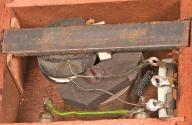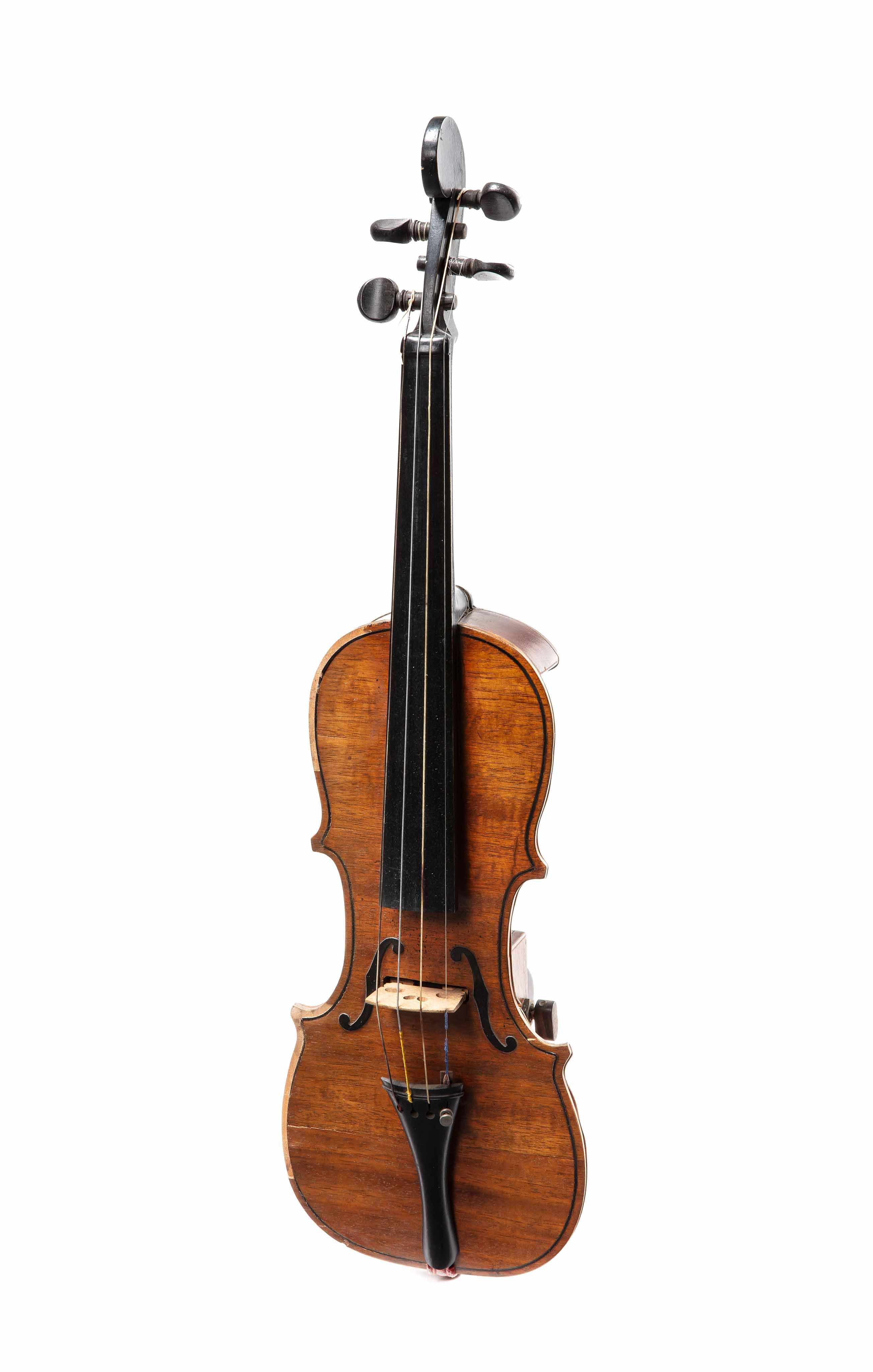Home
>
Works
>
Electric violin
>
Advanced Search
Bowed Strings
Violins
Electric violin
Alternate name:Electric (magneto-acoustic) violin
Alternate name:Solid-body electric violin
Maker: Vivi-Tone Company
Maker: Acousti-Lectric Company
Date: 1932 ca.
Place Made:Kalamazoo, Michigan, United States, North America
Model: ViVi-Tone
Serial No: none
SignedSpray painted in black on upper portion of back, the “Tone” lettering vertical: ViVi / =Tone
MarkingsBridge stamped toward tailpiece: DRESDEN
DescriptionElectric (magneto-acoustic) violin with slender, violin-shaped top mounted on a mahogany bar with outwardly curved lower side, and partial ribs and back at upper and lower ends only. Bridge fit in to slot in top, resting (over a wooden and dark-red plastic platform) on a paramagnetic metal bar-armature, the vibration of which varies the intensity of the magnetic field between two pole pieces (each attached to opposite polar ends of a U-shaped permanent magnet), inducing an electric current in a wire coil-winding surrounding one of the pole pieces. The ends of the wire coil-winding are connected to a variable resistance volume-control unit (with an adjusting knob), from which wires extend to the tip-jacks. The bar-armature is divided into two sections with unfriendly resonances using either a notch or a dividing block to prevent its own natural frequency vibrations from overwhelming other frequencies. Through differing divisions of the bar-armature, its total length, its thickness and width, and stiffness or elasticity, it is possible for the manufacturer to pre-determine the tonal qualities of the instrument. The electrical output of the magneto-acoustic unit is sufficient for use with headphones for practice, or it can be fed into an amplified loud-speaker
Top: plywood: thin mahogany veneer, the grain running perpendicular to strings, over maple base, with thin birch veneer on underside, the grain running perpendicular to strings; narrower than standard violin outline
Back: plywood: partial back comprised of separate sections at neck heel and endpin
Ribs: mahogany: grain runs parallel to strings; partial ribs at top and back
Head and neck: black-painted maple: thin, simplified headstock with outline of scroll, and no pegbox; strings run to nut on each side of central headstock piece
Arching: none
Edging: not scooped
Purfling: single black strip inlaid into mahogany veneer
Varnish: medium-dark brown
Fingerboard: black-painted maple; integral with neck and headstock; glued to top for 73 mm from top edge
Nut: black-painted ebony; thin
Tailpiece: ebony
Tailgut: red gut
Pegs: four ebony with mother-of-pearl eyes; short stems
Saddle: strip of red felt between endpin and end of tailpiece
Endpin: black plastic
F-holes: raised, black stencils; small; rounded notch corners
Linings: none
Corner blocks: none
Top block: none
Bottom block: none
Top: plywood: thin mahogany veneer, the grain running perpendicular to strings, over maple base, with thin birch veneer on underside, the grain running perpendicular to strings; narrower than standard violin outline
Back: plywood: partial back comprised of separate sections at neck heel and endpin
Ribs: mahogany: grain runs parallel to strings; partial ribs at top and back
Head and neck: black-painted maple: thin, simplified headstock with outline of scroll, and no pegbox; strings run to nut on each side of central headstock piece
Arching: none
Edging: not scooped
Purfling: single black strip inlaid into mahogany veneer
Varnish: medium-dark brown
Fingerboard: black-painted maple; integral with neck and headstock; glued to top for 73 mm from top edge
Nut: black-painted ebony; thin
Tailpiece: ebony
Tailgut: red gut
Pegs: four ebony with mother-of-pearl eyes; short stems
Saddle: strip of red felt between endpin and end of tailpiece
Endpin: black plastic
F-holes: raised, black stencils; small; rounded notch corners
Linings: none
Corner blocks: none
Top block: none
Bottom block: none
DimensionsTotal electric violin length: 597 mm
Top length: 355 mm
Upper bout top width: 128 mm
Center bout top width: 89 mm
Lower bout top width: 169 mm
Back length: upper section: 77 mm; lower section: 75 mm
Back width: upper section: 113 mm; lower section: 139 mm
Upper rib height: 32-33 mm
Lower rib height: 31 mm
Vibrating string length: 325 mm
Stop length: 192 mm
Neck length (bottom of nut to ribs): 133 mm
Top length: 355 mm
Upper bout top width: 128 mm
Center bout top width: 89 mm
Lower bout top width: 169 mm
Back length: upper section: 77 mm; lower section: 75 mm
Back width: upper section: 113 mm; lower section: 139 mm
Upper rib height: 32-33 mm
Lower rib height: 31 mm
Vibrating string length: 325 mm
Stop length: 192 mm
Neck length (bottom of nut to ribs): 133 mm
ProvenanceArne B. Larson Collection, Vermillion, South Dakota, 1979. Given to Larson by Lloyd Loar, Evanston, Illinois, in 1940, while he studied acoustics with Loar at Northwestern University.
Terms
Credit Line: Arne B. Larson Collection, 1979
Not on view
Published ReferencesMargaret Downie Banks, "Please Don’t Touch the Theremin! Stein Collection of Electronic Instruments Donated to Museum," Shrine to Music Museum Newsletter 23, No. 3 (April 1996), pp. 1-3.
Arian Sheets, "Lloyd Loar's Other Instruments . . . Four Rarities From the Workshop of an Electroacoustic Pioneer," National Music Museum Newsletter 32, No. 1 (February 2005), pp. 1-3
Lynn Wheelwright, The Pinecaster, The Pioneers Vol 1. (Valencia, Spain: Manfredo Music SL, 2021) p. 26.
Arian Sheets, "Lloyd Loar's Other Instruments . . . Four Rarities From the Workshop of an Electroacoustic Pioneer," National Music Museum Newsletter 32, No. 1 (February 2005), pp. 1-3
Lynn Wheelwright, The Pinecaster, The Pioneers Vol 1. (Valencia, Spain: Manfredo Music SL, 2021) p. 26.
Object number: 00057


















